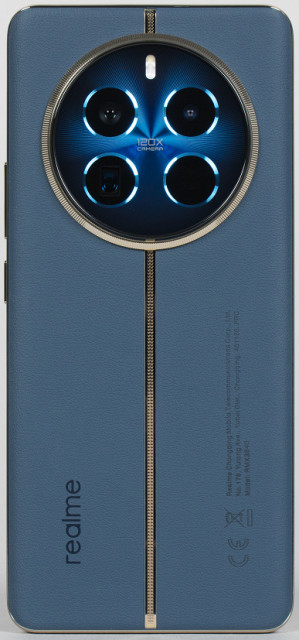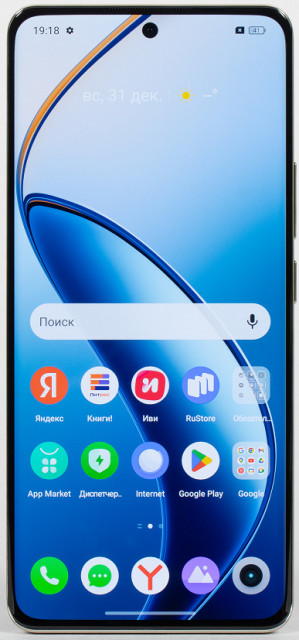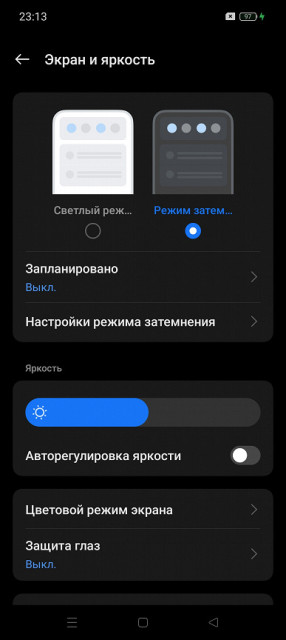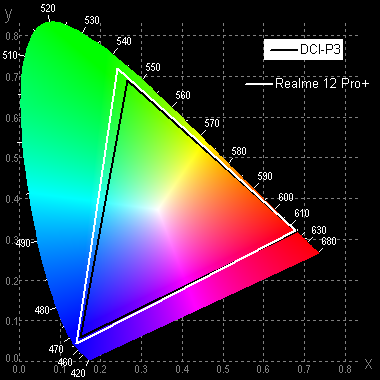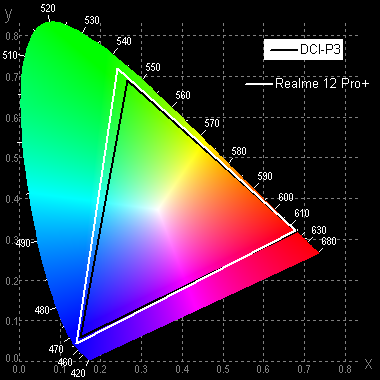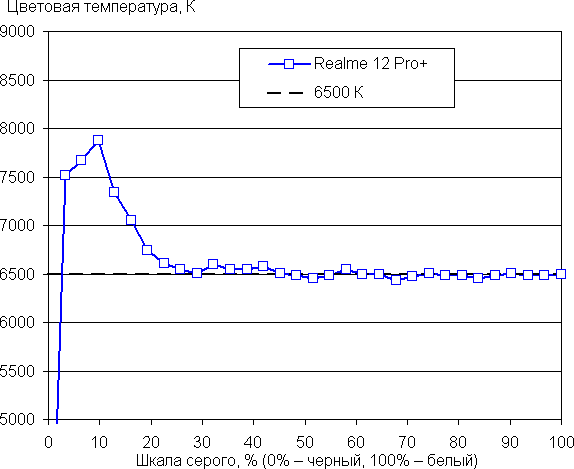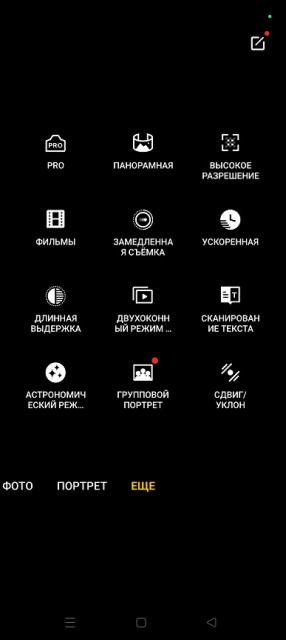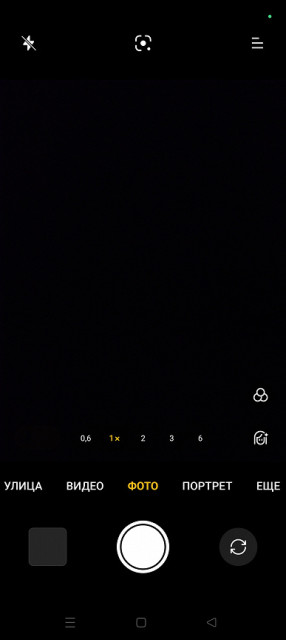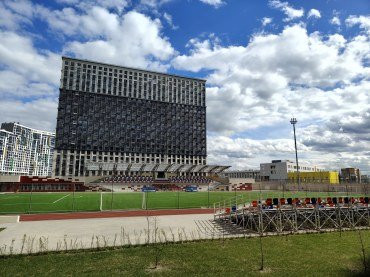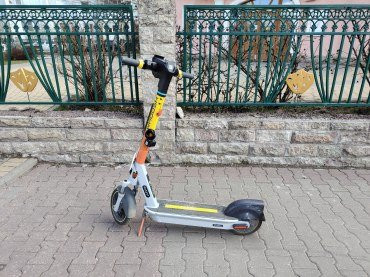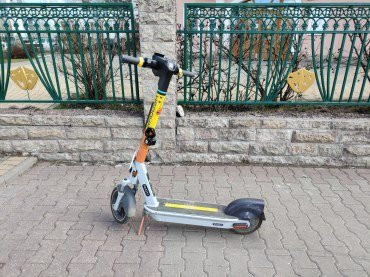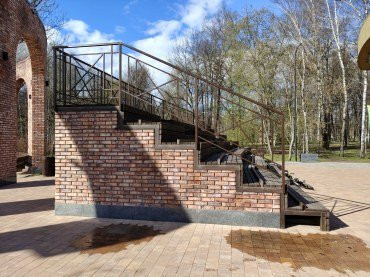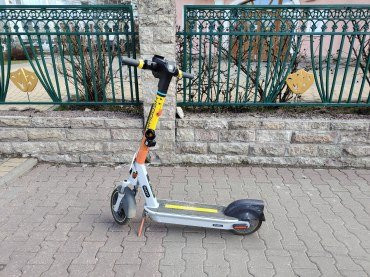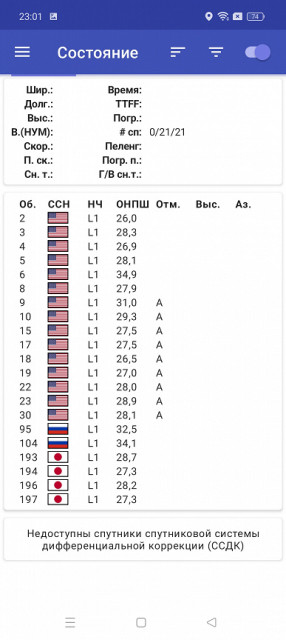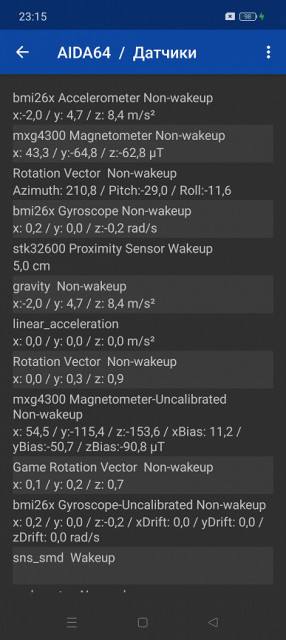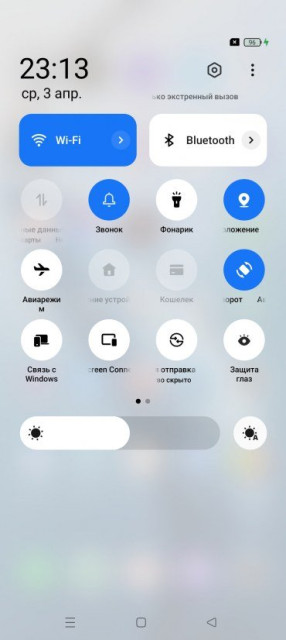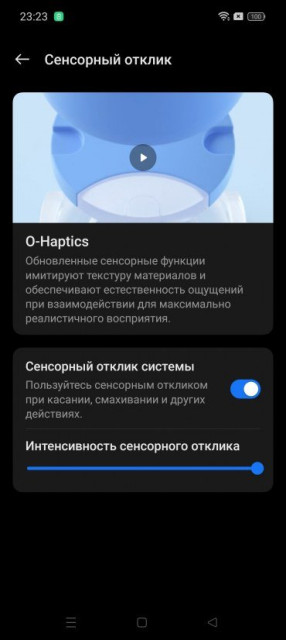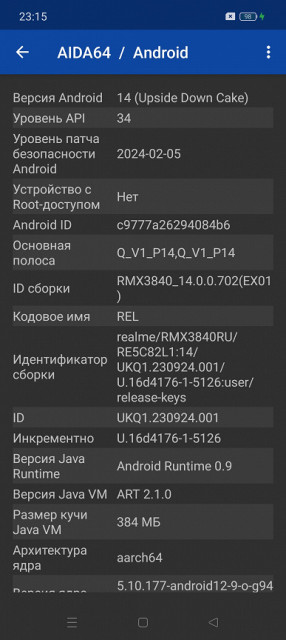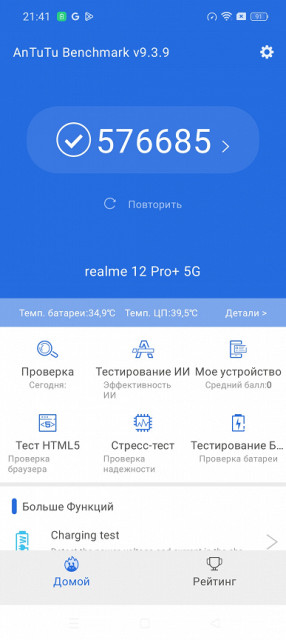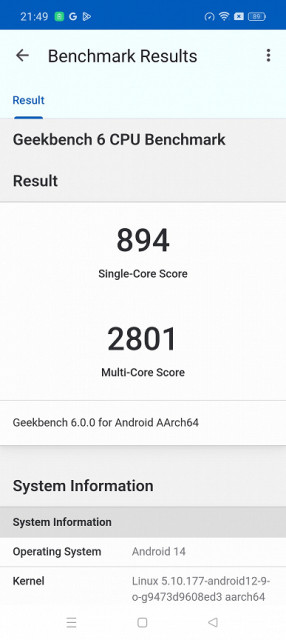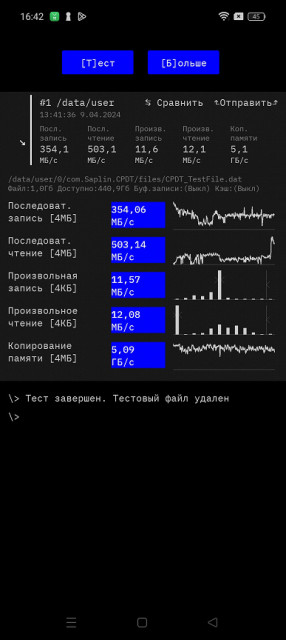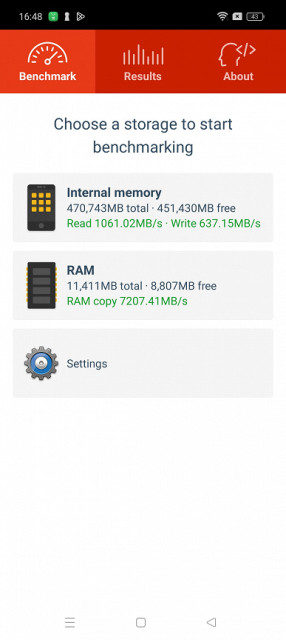Realme has once again pleased its fans with an amazing product. The Realme 12 Pro+ not only stands out for its sleek design, but also for its impressive triple camera arsenal. This device can easily be called a sub-flagship, which confirms its characteristics. We'll look at this in more detail in our review.
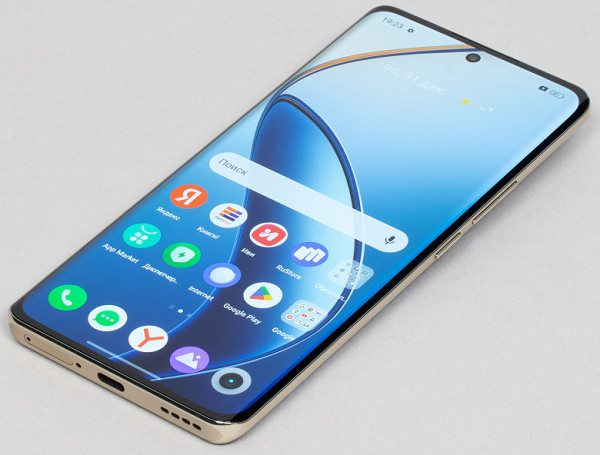
Key specifications of Realme 12 Pro+ (model RMX3840)
- SoC Qualcomm SM7435-AB Snapdragon 7s Gen2, 8 processor cores (4×Cortex-A78 @2.40 GHz + 4×Cortex-A55 @1.95 GHz)
- GPU Adreno 710
- Operating system Android 14, Realme UI 5.0
- Touch display AMOLED, 6.7″, 1080×2412, 20:9, 394 ppi
- RAM 8/12 GB, internal memory 128/256/512 GB
- No microSD support
- Nano-SIM support (2 pcs.)
- Networks 2G GSM, 3G WCDMA, 4G LTE, 5G
- GPS, Glonass, Galileo, BDS, QZSS
- Wi-Fi 6 (2.4 and 5 GHz)
- Bluetooth 5.2, A2DP
- NFC
- USB 2.0 Type-C, USB OTG
- There is no 3.5mm audio output for headphones
- Rear cameras 50 MP + 64 MP (telephoto) + 8 MP (wide-angle), 4K@30 fps video
- Front camera 32 MP
- Proximity and lighting sensors, magnetic field, accelerometer, gyroscope
- Fingerprint scanner (under the screen)
- Battery 5000 mAh, charging 67 W
- Dimensions 162×74×8.8 mm
- Weight 196 g
Appearance and ease of use
The Realme 12 Pro+ smartphone comes in a hard cardboard packaging with a colorful design.
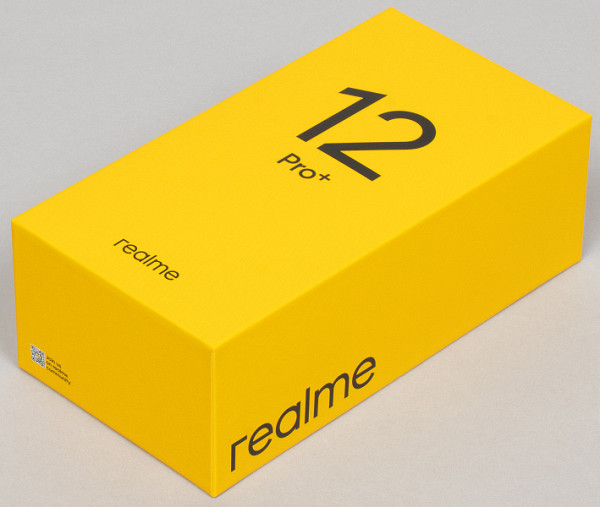
The kit includes a 67 W power supply, connecting cable and a transparent flexible case.

The Realme 12 Pro+ retains its signature sleek design with narrow sides and curved panels on both the front and back. Curved screens continue to be a hot trend, adding aesthetic appeal and charm to the device.

Realme continues to delight with the original design of its devices. This time the company collaborated with the famous Swiss watchmaker Olivier Saveo, who became famous for his work with Rolex. The result is a sophisticated detail — a camera frame created in the style of a watch bezel. Additionally, the shiny patterned stripe on the back gives the device a luxurious look, reminiscent of Rolex's elevated style.
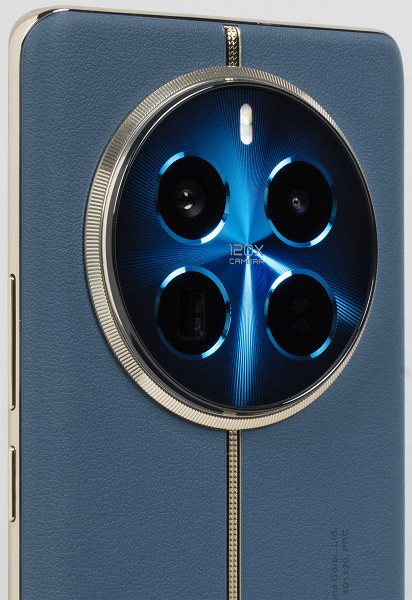
The materials used in Realme 12 Pro+ deserve praise: the side frame looks like real chrome-plated metal, and the back is made of high-quality eco-leather, in line with modern fashion trends. The thin bezel around the screen gives the device an elegant look even in the chin area. And the factory protective film on the screen guarantees the safety of the device from the very beginning of use.
The side buttons are located in their proper places right under the finger, the keys are large and tall, with a long, elastic stroke.

The included case is transparent and flexible, it almost does not overshadow the beauty of the design of the device itself.
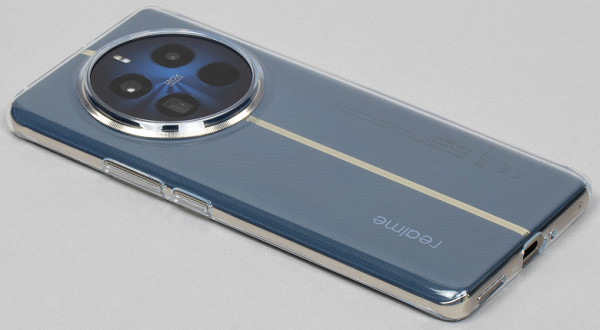
A single front camera eye is installed behind a circular cutout in the screen matrix in the center of the top edge.
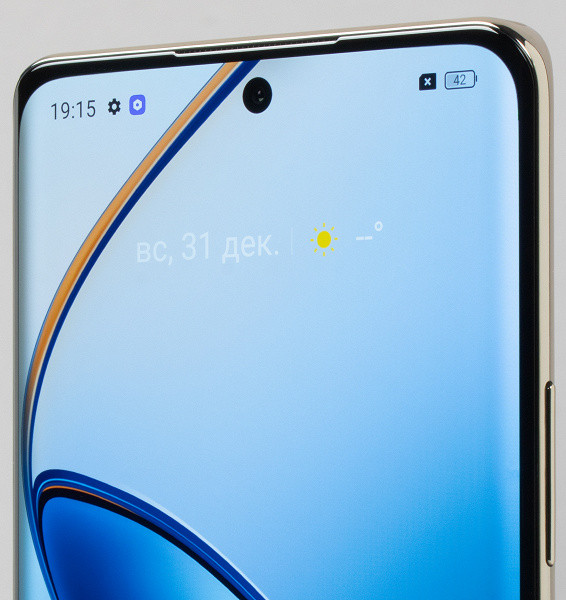
The fingerprint scanner of the Realme 12 Pro+ is located at the bottom of the screen glass. Although it is optical and responsive, many users prefer the capacitive scanner built into the side button, finding it more convenient to use.

The slot on the bottom can accommodate two Nano-SIM cards (on one side and the other side of the sled). Installation of a microSD memory card is not provided.
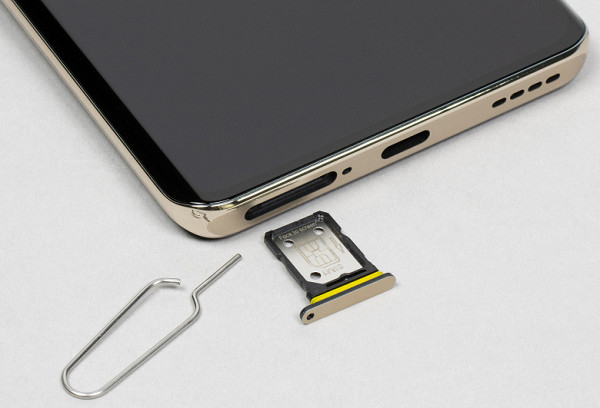
It is important to note the aesthetic appeal of the side frame of the Realme 12 Pro+, which smoothly transitions to the top and bottom ends, acquiring a smooth texture. At the bottom there is a speaker, microphone and USB Type-C connector. It should be noted that there is no 3.5 mm jack for connecting wired headphones.

The top end contains an additional microphone and a second loudspeaker — the smartphone has stereo speakers.

The device is available in several colors. The case is protected from moisture and dust according to the IP65 standard.
Screen
Realme 12 Pro+ features a 6.7-inch AMOLED display with a resolution of 1080×2412 (20:9) protected by a curved protective glass. The physical dimensions of the screen are 70x157 mm, with a dot density of 394 ppi. The width of the frame around the screen is 2 mm on the sides and 3 mm on the top and bottom. The screen supports a 120Hz refresh rate.
The front surface of the Realme 12 Pro+ screen is made of a glass plate with a mirror-smooth surface that is protected from scratches. The anti-glare properties of the screen are superior to the Nexus 7, and a special oleophobic coating makes it more resistant to dirt and fingerprints.
The maximum screen brightness is about 450 cd/m², in bright light it can reach 600 cd/m². The minimum brightness value is 1.7 cd/m², which ensures comfort when used in the dark. The automatic brightness adjustment function allows you to adapt it to the surrounding conditions.
At any brightness level, modulation is observed with a frequency of about 60, 120 or 2160 Hz.

At medium and high brightness levels, the modulation amplitude is small, eliminating visible flicker despite the low frequency of 60 Hz. When the brightness is reduced, modulation appears at a high frequency (2160 Hz), which also does not cause visible flicker.
A mode with an increased refresh rate of up to 120 Hz is available in the screen settings.

In 120 Hz mode, scrolling through menu lists is noticeably smoother. Let's see if this changes the nature of the modulation:
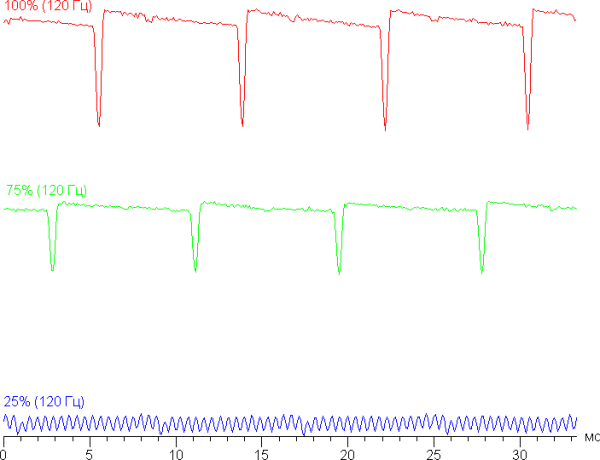
At high and medium brightness levels, the modulation frequency has doubled, but the absence of visible flicker remains. At low brightness, the modulation pattern has not changed, and there is no flickering either.
The Realme 12 Pro+ screen is equipped with a Super AMOLED matrix, where a full-color image is formed by subpixels of three colors: red ®, green (G) and blue (B). However, the number of red and blue subpixels is half that, which is reflected as RGBG.
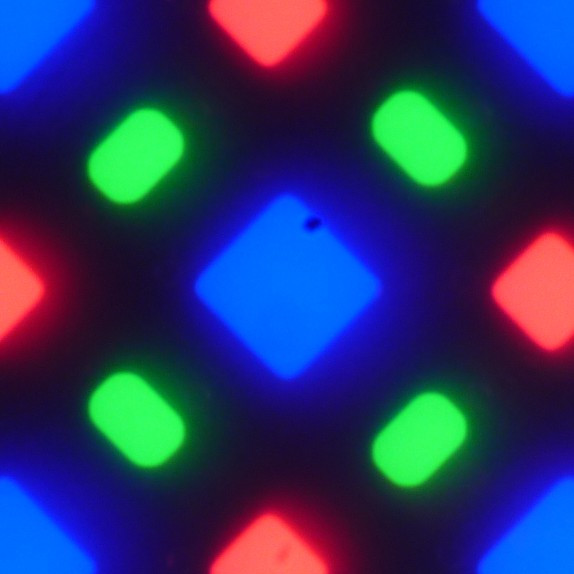
On this screen you can find 4 green subpixels, 2 red (4 halves) and 2 blue (1 whole and 4 quarters). By repeating these fragments, you can fill the entire screen without overlaps or gaps. Such matrices are called PenTile RGBG from Samsung. Screen resolution is calculated based on the number of green subpixels, which makes the resolution for other colors lower.
Screen viewing angles are excellent. While white may take on a subtle blue-green tint at wide angles, black remains true black at any angle. This allows the screen to provide high quality images.

It should be noted that the screen has good uniformity of brightness and color tone of the white field, with the exception of subtle dimming and hue changes towards the curved edges.
And here's a test image:

Colors on the smartphone screen look oversaturated, which is noticeable in tomatoes, bananas, napkins and facial shades. However, it is worth considering that photography does not always accurately convey the quality of color rendering due to the characteristics of the camera and the spectral sensitivity of the matrix, which does not coincide with human vision.
In addition, due to the curved edges of the screen, there is slight darkening and color distortion at the periphery of the image. It also interferes with viewing content, especially images or movies in full screen.
The photo was taken using the Vivid Colors profile, which is the default setting on your device.
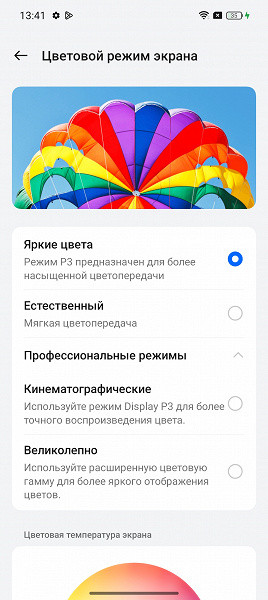
When you select the Cinematic profile, the color saturation is slightly lower and the color balance changes — the shades become warmer:

In the case of the Superb profile, the color saturation is the same as in the case of the Vivid colors profile, but the color contrast is slightly higher:

Whereas in the case of the Natural profile the situation is better:

Color saturation is normal, there is no increase in color contrast, and color balance is close to standard.
When viewed at an angle, a smartphone screen's brightness decreases less noticeably than LCD screens, making it visually brighter at the same formal brightness. This is especially true given that mobile devices have to be viewed at a slight angle.
Switching matrix elements occurs almost instantly, however, when turned on, a step with a width of approximately 17 ms (at a screen refresh rate of about 60 Hz) or about 8 ms (at 120 Hz) can be observed.

In some situations, the presence of such a step can cause the effect of “trails” that trail behind moving objects.
A gamma curve based on 32 points at equal intervals based on the numerical values of gray shades showed that there was no significant deterioration in either the highlights or shadows. The power function fit exponent is 2.29, which is slightly higher than the standard value of 2.2, resulting in a slightly darker image. In this case, the real gamma curve shows a slight deviation from the power-law dependence.
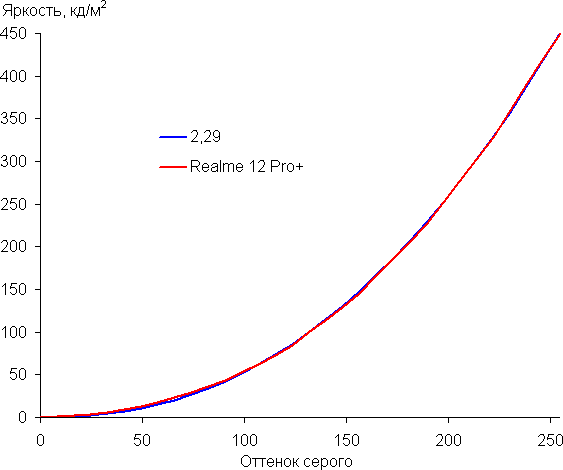
We remind you that on OLED screens, the brightness of individual image fragments dynamically changes depending on the nature of the displayed content — it decreases slightly for overall bright images. Therefore, the resulting dependence of brightness on hue (gamma curve) probably does not exactly correspond to the gamma curve of a static image, since the measurements were carried out with sequential output of shades of gray almost over the entire screen.
In Cinematic mode, the color gamut is wider than sRGB and almost corresponds to the DCI-P3 standard.

Cinematic
In the case of the Vivid Colors and Superb profiles, the coverage is slightly wider:
When you select the Natural gamut profile, it is compressed to the sRGB boundaries:

In the case of the Vivid Colors and Superb profiles, the spectra of the components are very well separated, which allows for a wide coverage:
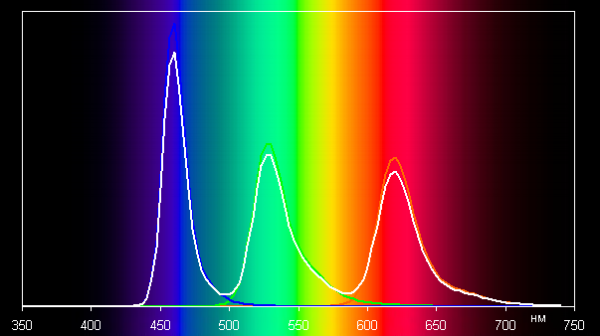
In the case of the Natural profile with maximum coverage correction, the color components are mixed together to a significant extent:

It's important to note that on wide-gamut screens, images that are not corrected for sRGB devices may appear unnaturally saturated. Therefore, it is most often recommended to select the “Natural” profile to watch movies, photos and other natural content. The Cinematic profile is useful when viewing material optimized for the DCI-P3 standard, which is rarely seen in everyday life.
The balance of shades on the gray scale when choosing the “Natural” profile is usually good — the color temperature is close to the standard 6500 K, and changes in this parameter in significant areas of the gray scale are minimal, which improves the visual perception of color balance. The deviation from the blackbody spectrum (ΔE) is typically less than 10 units, which is a good indicator for a consumer device, and the spread of this characteristic is also small.
In most cases, you can ignore the darkest areas of the gray scale, since color balance does not play a big role there, and the error in measuring color characteristics at low brightness is quite high.
In addition, this device allows you to correct the color balance by selecting a color temperature profile or adjusting the hue on the color wheel.
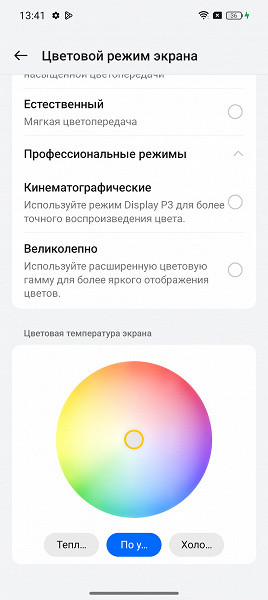
But there is no particular point in doing this; just select the Natural profile. You can also reduce the intensity of the blue component in the settings.

In general, bright light can affect your circadian rhythm, but this can be easily managed by simply dimming the brightness to a comfortable level without having to change the color balance by reducing the blue light.
It seems that this device does not support DisplayPort Alt Mode for USB Type-C — the ability to output image and sound to an external device via a USB port.
To summarize, the screen has a high maximum brightness (up to 600 cd/m²) and excellent anti-glare properties, which allows you to use the device even in bright sunlight. In complete darkness, you can comfortably control the brightness to a minimum value (1.7 cd/m²). The automatic brightness adjustment mode also works effectively. Among the advantages of the screen are an effective oleophobic coating, no flicker, a high refresh rate mode (120 Hz), a color gamut close to sRGB and good color balance when choosing the right profile.
It is also important to note the general advantages of OLED screens: true black color, uniform white field and minimal drop in brightness when viewed at an angle.
It is also worth mentioning that curved edges can negatively affect image quality, leading to color distortion and reduced brightness at the edges. However, overall the screen quality remains very high.
Camera
The Realme 12 Pro+ smartphone is equipped with a full set of three rear cameras with different focal lengths: main, telephoto and wide-angle. A full-fledged “telephoto” is a rarity these days.
- 50 MP, 1/1.56″, 1.0 µm, f/1.8, 24 mm, multi-directional PDAF, OIS (main)
- 64 MP, 1/2.0″, 0.7 µm, f/2.8, 71 mm, PDAF, OIS, 3× optical zoom (telephoto)
- 8 MP, 1/4.0″, 1.12 µm, f/2.2, 16 mm, 112˚ (wide angle)
The main camera is equipped with a 50-megapixel Sony IMX890 sensor, providing fast and reliable phase detection autofocus and optical stabilization. By default, photos are taken at 12.5 megapixel resolution with pixel binning for improved detail. While it's possible to shoot at full resolution, photos in the 50-megapixel mode look less detailed and even appear a little pixelated, as if digital zoom has been used.
The main camera performs very well, achieving at least an average, and even a high level when eliminating unsuccessful shots (although it is recommended to take backup shots or check the results of the shooting on the spot). Photos are highly detailed and sharp, have excellent contrast, and autofocus is fast and accurate. The color scheme looks natural, without oversaturation, while maintaining brightness and depth. Thus, the quality of the images turns out to be quite decent, although it does not reach the level of flagship cameras. If necessary, color saturation can be enhanced using built-in color filters.
Here are some more examples of pictures taken with the main camera in automatic mode:
In night mode, the processing is more noticeable, but even here the result is quite attractive. But the halos from light sources are unpleasant, something needs to be done about it. The exposure is completely adequate.
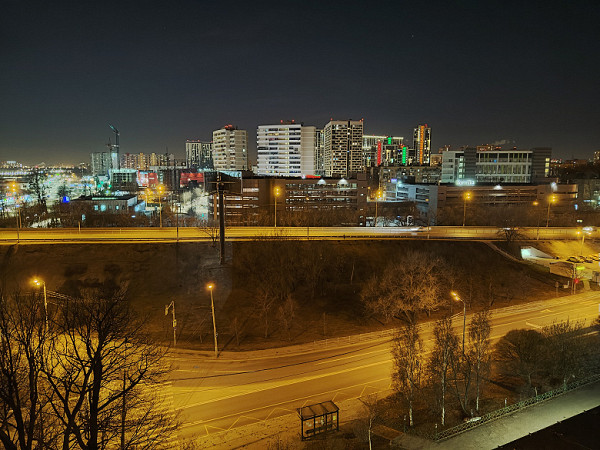
In addition to the excellent main camera, the device has a full-fledged periscope telephoto lens that provides 3x optical zoom. This module is also equipped with autofocus and optical stabilization, which is an important aspect for long focal lengths. Photos with the telephoto lens are captured at both pixel binning (16MP) and full resolution (64MP), although the benefits of higher resolution aren't always noticeable. At the same time, the quality of shooting remains at a high level, not inferior to the main camera: correct geometry, good elaboration of light, shadows and shades, high sharpness and three-dimensionality of images. What especially stands out is the presence of a 3x optical zoom, which makes this module one of the key advantages of the Realme 12 Pro+.
The wide-angle camera in this device is the least advanced of the entire arsenal: its sensor resolution is low, and it lacks both image stabilization and autofocus. Detail is also noticeably lower, although photo clarity remains acceptable unless you focus on the very edges of the frame. For an ultra-wide-angle camera in a mobile device, the quality is quite good, but it is not comparable to the other two modules of this smartphone.
Video recording capability is available in 4K@30fps or 1080p@60fps. The image quality when recording video is quite decent: brightness and clarity are high, detail is high, and autofocus works accurately. There are no obvious highlights, and volume reproduction is quite expressive, with the exception of a somewhat unnatural color rendering where colors appear overly saturated. However, when shooting in 4K format, there is a critical lack of stabilization, which becomes available only when moving to 1080p resolution. However, the image loses a little clarity and may appear less dense. As a result, it is recommended to use the 4K format for static scenes, and when shooting dynamic moments, it is preferable to switch to 1080p mode with active electronic stabilization. The sound quality when recording videos is also decent.
The front camera is equipped with a high-resolution sensor (32 megapixels), which allows you to emulate two different focal lengths due to the crop. Images with a resolution of 32 megapixels, although not bad, look better if you reduce the resolution (for example, to 8 megapixels): detail, geometry, volume and color rendition are at a high level. Portrait mode enhances photos by blurring the background for an artistic touch. The quality of pictures when using the front camera is very high.
Telephone and communications
The Realme 12 Pro+ smartphone has excellent networking capabilities. It supports most 4G and 5G mobile networks, as well as dual-band Wi-Fi 6, Bluetooth 5.2 and NFC. The only missing element is e-SIM support. In the urban areas of the Moscow region, the device demonstrates stable operation in wireless networks, does not lose connection and quickly restores it after a break. Built-in sensors, including a gyroscope, work reliably.
The single-channel satellite navigation module supports GPS, Glonass, BDS, Galileo and QZSS. Satellites are detected quickly during a cold start, and positioning accuracy leaves little to be desired.
The voice of the interlocutor in the speaker sounds loud and speech is easy to understand. The vibration alert is pleasant and soft, with medium power thanks to the advanced O-Haptics vibration response system.
Software and multimedia
Realme 12 Pro+ runs on Android 14 operating system with Realme UI 5.0 skin. The shell functions reliably and is well optimized, but it contains an excessive number of pre-installed applications and sometimes displays pop-up ads.
One interesting feature is the Dynamic Port, similar to the Dynamic Island on iPhone devices, which creates a special area around the front camera with basic information and notification functions.
The notification shade is not divided into two parts. The device comes pre-installed with the Google Play application store, as well as a duplicate App Market store.
The Realme 12 Pro+ comes with stereo speakers that deliver clear, though not the loudest, sound. The device does not have a 3.5mm audio output for wired headphones, but supports a wide range of Bluetooth codecs for wireless headphones, including AAC, SBC, aptX, aptX HD, aptX Adaptive, aptX TWS+, LDAC and LHDC.
Performance
The Realme 12 Pro+ is powered by an octa-core Qualcomm SM7435-AB Snapdragon 7s Gen2 processor and Adreno 710 GPU. The device is available with 8GB or 12GB LPDDR4X RAM (with an additional 12GB virtual memory) and internal storage options of 128GB, 256GB, and 512GB. Unfortunately, it is impossible to install a memory card, but connecting external devices via the USB Type-C port in USB OTG mode is supported.
The platform was presented on September 15, 2023 and was manufactured using a 4-nanometer process technology. Test results in AnTuTu reach close to 600,000 points, which provides the device with decent mid-level performance. This is enough to perform various tasks and smooth operation of the user interface, as well as for a comfortable gaming experience.
Testing in comprehensive tests AnTuTu and GeekBench:
All results of testing the smartphone in the latest versions of popular benchmarks have been systematized and presented in tables for ease of analysis. Typically, these tables include several other devices from different market segments that have also been tested on similar versions of the benchmarks. This allows for a clear comparison of the results obtained. However, due to limitations, it is impossible to present results from different versions of benchmarks within a single comparison, so many noteworthy models remain “behind the scenes”, since they were tested on previous versions of test programs.
| Realme 12 Pro+ (Qualcomm Snapdragon 7s Gen2) | Huawei nova 12s (Qualcomm Snapdragon 778G) | OnePlus Nord 3 5G (Mediatek Dimensity 9000) | Tecno Spark 20 Pro+ (Mediatek Helio G99 Ultimate) | Redmi Note 13 Pro+ (Mediatek Dimensity 7200 Ultra) | |
|---|---|---|---|---|---|
| AnTuTu (v9.x) (bigger is better) | 576685 | 546957 | 789188 | 387428 | 669583 |
| GeekBench 6 (bigger is better) | 894/2801 | 996/2453 | 1077/3175 | 744/2019 | 1126/2643 |
Testing the graphics subsystem in GFXBenchmark gaming tests:
| Realme 12 Pro+ (Qualcomm Snapdragon 7s Gen2) | Huawei nova 12s (Qualcomm Snapdragon 778G) | OnePlus Nord 3 5G (Mediatek Dimensity 9000) | Tecno Spark 20 Pro+ (Mediatek Helio G99 Ultimate) | Redmi Note 13 Pro+ (Mediatek Dimensity 7200 Ultra) | |
|---|---|---|---|---|---|
| GFXBenchmark Aztec Ruins OpenGL (Onscreen, fps) | 35 | 34 | 96 | 16 | 50 |
| GFXBenchmark Aztec Ruins Vulkan (Onscreen, fps) | 39 | 38 | 105 | 14 | 55 |
| GFXBenchmark Car Chase ES 3.1 (1080p Offscreen, fps) | thirty | 33 | 79 | 15 | 43 |
| GFXBenchmark Manhattan ES 3.1 (1080p Offscreen, fps) | 54 | 56 | 151 | 26 | 74 |
| GFXBenchmark T-Rex (1080p Offscreen, fps) | 122 | 133 | 293 | 64 | 191 |
Testing in browser cross-platform tests:
| Realme 12 Pro+ (Qualcomm Snapdragon 7s Gen2) | Huawei nova 12s (Qualcomm Snapdragon 778G) | OnePlus Nord 3 5G (Mediatek Dimensity 9000) | Tecno Spark 20 Pro+ (Mediatek Helio G99 Ultimate) | Redmi Note 13 Pro+ (Mediatek Dimensity 7200 Ultra) | |
|---|---|---|---|---|---|
| Google Octane 2 (bigger is better) | 30529 | 24923 | 29390 | 24024 | 39276 |
| JetStream (bigger is better) | 85 | 67 | 76 | 75 | 79 |
Memory speed test results:
Heat
We test for performance degradation when heated using the Burnout Benchmark program, which allows you to load the CPU, GPU and NPU:
| Stress on | Heating performance as a percentage of maximum |
|---|---|
| CPU | 46% |
| GPU | 67% |
| NPU | 25% |
Battery life
The Realme 12 Pro+ smartphone comes with a 5,000mAh battery, which is considered standard by today's standards. During testing, the device demonstrated a high level of battery life, confirming the effectiveness of the platform.
Testing was carried out with normal power consumption without activating power saving features, despite their presence in the device. The screen brightness was set to the minimum comfortable level, approximately 100 cd/m². Tests included continuous reading in the Moon+ Reader app using the standard light theme, continuous HD video playback (720p), and Injustice 2 with automatic graphics settings.
| Battery capacity | Reading mode | Video mode | 3D Game Mode | |
|---|---|---|---|---|
| Realme 12 Pro+ | 5000 mAh | 23:00 | 20:00 | 7:00 am |
| Tecno Spark 20 Pro+ | 5000 mAh | 18:00 | 14:00 | 6:00 am |
| Vivo V30 | 5000 mAh | 23:00 | 21:00 | 8:00 am |
| Vivo V29 | 4600 mAh | 21:00 | 19:00 | 8:30 a.m. |
| Infinix GT 10 Pro | 5000 mAh | 20:30 | 18:00 | 8:30 a.m. |
| Tecno Camon 20 Pro 5G | 5000 mAh | 19:00 | 16:00 | 7:00 am |
| Vivo V27 | 4600 mAh | 25:00 | 19:00 | 7:00 am |
All results mentioned represent the maximum achievable results obtained under ideal conditions, including no SIM cards installed. Any changes in usage will likely result in poorer results.
The Realme 12 Pro+ smartphone charges in one hour using the included 67W wall charger. It does not support wireless charging.
Bottom line
While the Realme 12 Pro+'s Qualcomm platform may seem average, its AMOLED display is of high quality. Particularly worth highlighting is the full-fledged telephoto lens with a periscope design and 3x optical zoom, which complements the already good main camera. This combination of features makes this model truly stand out and appeal to users.

